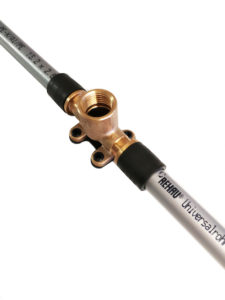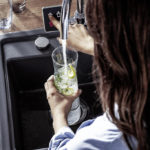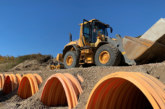One of the most important factors in maintaining water quality is the choice of plumbing system material. However, solutions today are being scrutinised due to growing concern surrounding contamination of drinking water supplies from metallic components, leaving building services professionals searching for new, innovative alternatives. Franz Huelle, Head of Technical at REHAU Building Solutions reports.
Plumbing systems and materials are constantly evolving, from the first terracotta systems to modern-day PE-Xa pipework. Perhaps the most infamous of those was lead, which, following better understanding of its health risks, was banned from use in pipework more than 40 years ago.
Since then, material choices in plumbing have changed, with specifiers and building service providers often favouring brass and copper. Yet, their use is now being scrutinised due to potential health risks associated with these materials leaching into water supplies via metallic components.
Addressing the issue
Concerns about metallic leaching into drinking water supplies were voiced by The UK’s Water Regulators in an open letter earlier this year. It referred to findings from UK Water Industry Research (UKWIR), which drew the link between metallic fittings in contact with drinking water and elevated concentrations of metal ions in drinking water supplies. Increased levels of nickel and lead within the supply, potentially leached from some brass fittings, were also particularly prominent in the UKWIR’s research.
The current reference point for assessing the impact of non-metallic materials used in pipework is represented by criteria in British Standard (BS) 6920. The Water Regulator’s Advice Service’s (WRAS) approval scheme has for many years included this evaluation of levels of metal leaching from non-metallic fittings in contact with drinking water supplies.
Though testing determining potentially adverse effects metallic components have on water supplies exist, the letter declared this testing, set out in the British Standards Institute’s 2002 ‘Draft for Development Standard’ unsuitable and unrepresentative of real use. Investigations in this area have also highlighted that, unlike non-metallic testing, no corresponding system or reliable testing determining the long-term leaching effects of metallic fittings is in place.
Recent scientific research dictates that, in the initial months following installation, metal-leaching rates from new metallic fittings can rise. In response, the 4MS Group — an initiative between the UK, France, the Netherlands and Germany to harmonise drinking water requirements — organised performance criteria guiding the correct use of metallic plumbing fittings coming into contact with water.
 Avoiding risk
Avoiding risk
BS EN 15664 sets precedents for assessing potentially harmful contamination of drinking water from metallic materials. Metals adhering to BS EN 15664 can be used for plumbing fittings to reduce metal leaching into water and are added to the ‘Common Composition List’, available via the 4MS website.
Nevertheless, unless fittings are completely lead-free, a small risk of lead leaching into will always remain. It is also worth acknowledging, under current regulations; the 4MS Group’s criteria are optional. Therefore, despite improved products’ compliance reducing consumer risk, a guaranteed level of protection cannot be assured as not all available metallic fittings have been assessed correctly.
For the first time in preparation for being added, the candidate list for Annex XIV under the Registration, Evaluation, Authorisation and Restriction of Chemicals (REACH) regulations has recently included lead. Sometimes referred to as the REACH Authorisation List, Annex XIV lists chemical substances deemed a Substance of Very High Concern that should no longer be available on the market or used after a given date, expect with specific authorisation.
With pressure on manufacturers and plumbing solutions providers to ensure they use compliant materials for fittings and focus on using lead-free, non-metallic leaching materials in pipework, the need for alternatives is larger than ever.
Protection through polymer
Such investigations and codes of practice mean specifiers, designers and other building service providers may consider it more sensible to opt for non-metallic components when selecting a plumbing solution, using fittings with materials found in the ‘Common Composition List’.
Though discussion surround the use of plastic over metal fittings in plumbing systems continues, risk of metal leaching into drinking water should render polymer-based systems the more practical alternative. Given advances in polymer solutions, plastic alternatives are now more than and more flexible and more hygienic choice for contractors.
Systems such as REHAU’s RAUTITAN heating and plumbing solution comply with standards, particularly with the recent introduction of its REACH-compliant, lead-free gunmetal RX+ fitting. A durable and easy-to-install system for safe drinking water solutions, the product’s cavity-free impermeable joints eliminate risk of microbial contamination and smooth surface prevent deposits forming. Thanks to this and the new RX+ fitting, both RAUTITAN flex and the multilayer RAUTITAN stabil have been awarded WRAS approval.
Reducing quantities of metallic components and adhering to BS EN 15664, Annex XIV of REACH, and the ‘Common Composition Lists’, will put specifiers and designers at ease knowing water quality will remain high. If stakeholders instead opt for using inadequately tested metallic fittings, they could risk contamination from long-term leaching. In addition to the negative impact on health, this could also damage contractors’ reputation going forward.









